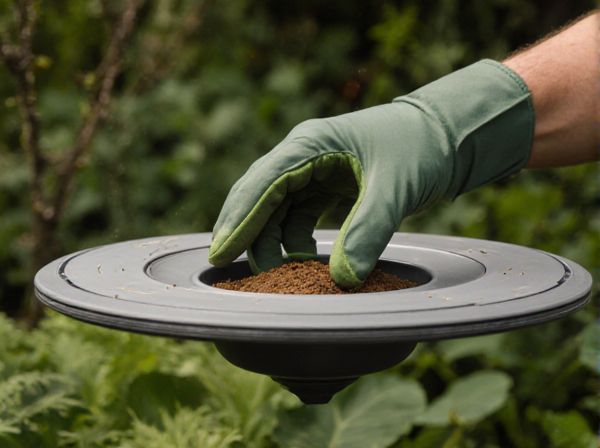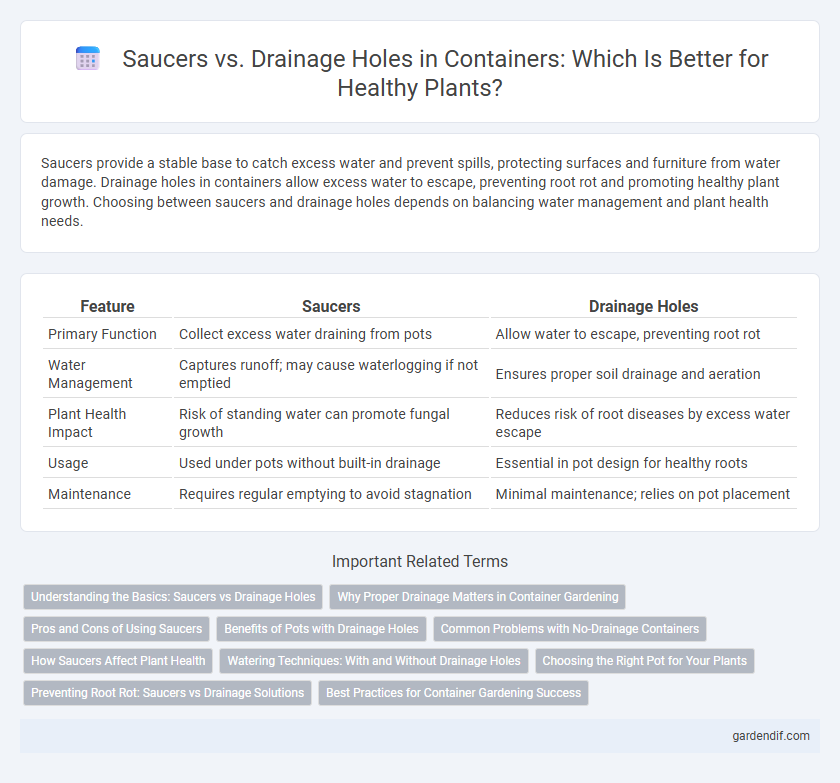
Saucers vs drainage holes Illustration
Saucers provide a stable base to catch excess water and prevent spills, protecting surfaces and furniture from water damage. Drainage holes in containers allow excess water to escape, preventing root rot and promoting healthy plant growth. Choosing between saucers and drainage holes depends on balancing water management and plant health needs.
Table of Comparison
| Feature | Saucers | Drainage Holes |
|---|---|---|
| Primary Function | Collect excess water draining from pots | Allow water to escape, preventing root rot |
| Water Management | Captures runoff; may cause waterlogging if not emptied | Ensures proper soil drainage and aeration |
| Plant Health Impact | Risk of standing water can promote fungal growth | Reduces risk of root diseases by excess water escape |
| Usage | Used under pots without built-in drainage | Essential in pot design for healthy roots |
| Maintenance | Requires regular emptying to avoid stagnation | Minimal maintenance; relies on pot placement |
Understanding the Basics: Saucers vs Drainage Holes
Saucers and drainage holes are essential features in container gardening that manage excess water to protect plant roots from waterlogging and root rot. Drainage holes allow excess water to escape from the bottom of the container, ensuring proper aeration and preventing soil saturation. Saucers, placed beneath containers without drainage holes, catch drained water to prevent messes and enable careful water monitoring, but containers with drainage holes remain preferable for optimal plant health.
Why Proper Drainage Matters in Container Gardening
Proper drainage in container gardening prevents waterlogging, which can lead to root rot and stunted plant growth. While saucers catch excess water and protect indoor surfaces, they can trap moisture if not monitored, causing poor aeration and fungal issues. Incorporating drainage holes ensures excess water escapes, maintaining healthy soil oxygen levels crucial for robust root development and overall plant vitality.
Pros and Cons of Using Saucers
Saucers offer the advantage of catching excess water, preventing damage to surfaces and enabling controlled moisture retention for potted plants. However, they can lead to waterlogging if not regularly emptied, creating a risk of root rot and attracting pests like mosquitoes. Unlike drainage holes, which allow excess water to escape freely, saucers require active maintenance to balance moisture and prevent negative effects on plant health.
Benefits of Pots with Drainage Holes
Pots with drainage holes prevent water accumulation, reducing the risk of root rot and promoting healthier plant growth. These containers enable excess water to escape, ensuring proper aeration and nutrient absorption in the soil. Proper drainage supports optimal root development and long-term plant vitality.
Common Problems with No-Drainage Containers
Containers without drainage holes often cause water to accumulate at the bottom, leading to root rot and poor oxygen availability for plants. Excess moisture creates an environment conducive to fungal infections and pests, compromising plant health. Proper drainage is essential to prevent these issues and promote optimal root development.
How Saucers Affect Plant Health
Saucers help retain excess water, preventing soil from drying out too quickly and promoting consistent moisture levels essential for plant health. However, they can also cause waterlogging if not monitored, leading to root rot and decreased oxygen availability. Proper use of saucers requires balancing water retention with adequate drainage to maintain optimal root conditions.
Watering Techniques: With and Without Drainage Holes
Watering techniques for containers with drainage holes involve allowing excess water to flow out, preventing root rot and promoting healthy aeration. Containers without drainage holes require careful watering to avoid waterlogging, such as using a saucer to catch excess water and allowing the soil surface to dry between waterings. Monitoring soil moisture with a moisture meter or finger test helps optimize watering frequency and ensures plant roots receive adequate hydration without oversaturation.
Choosing the Right Pot for Your Plants
Choosing the right pot for your plants involves understanding the difference between saucers and drainage holes. Drainage holes ensure excess water escapes, preventing root rot and promoting healthy root growth, while saucers catch excess water to protect surfaces but can cause waterlogging if not monitored. For optimal plant health, select containers with drainage holes and pair them with a saucer that allows easy water removal to balance moisture levels effectively.
Preventing Root Rot: Saucers vs Drainage Solutions
Saucers help catch excess water, preventing overwatering but can trap moisture that encourages root rot without proper drainage. Drainage holes allow excess water to escape, reducing stagnant moisture and promoting healthy root aeration essential for preventing rot. Combining drainage holes with a well-suited saucer that doesn't retain excess water optimizes moisture control and plant health.
Best Practices for Container Gardening Success
Saucers are essential in container gardening to prevent water runoff and protect surfaces, while drainage holes ensure excess water escapes, preventing root rot and promoting healthy plant growth. Best practices include selecting containers with adequate drainage holes and using saucers to catch overflow, maintaining soil moisture without waterlogging. Regularly emptying saucers prevents stagnant water, reducing the risk of pests and diseases.
Saucers vs drainage holes Infographic

 gardendif.com
gardendif.com